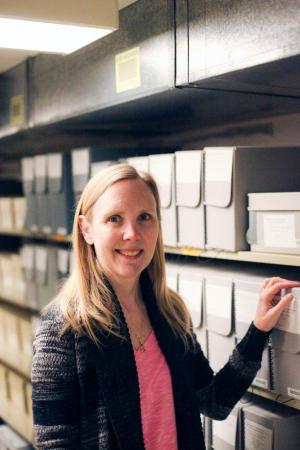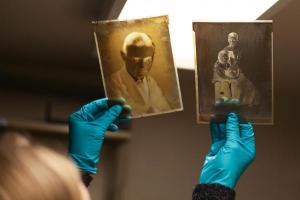Q&A: Jennifer Sanchez
Throughout 2018, the University of Colorado Boulder Libraries is celebrating the centennial anniversary of the CU Boulder Archives.
This spring, members of the CU community are invited to take part in the CU Boulder Archives Centennial Celebration, where visitors may take a peek at the past 100 years of the archives, chat with archivists working with the collections, and learn more about the future of archives. Click here to learn more about the June 6 event.
Archivists say they are moving toward increased community inclusion, process transparency, and accessibility of all collections held at CU Boulder.
Among those archivists is Jennifer Sanchez. Her story below, first posted by University Libraries, is part of an ambitious series: 100 Stories for 100 Years. Click here for a directory of the other installments.
As the photo archivist for the University Libraries, tell us, what does a photo archivist do?
I primarily work on preserving and providing access to photographic and audio/visual materials in the CU Boulder Archives. I manage the collections that are primarily composed of photographs and also help other archivists in our department when they have questions about photographs in the collections they are working on.
How did you become photo archivist?
I have worked at the American Heritage Center, the Library Company of Philadelphia and the University of Pennsylvania’s Rare Book Library as an archivist. In the two most recent positions, I worked directly with photographs and prints. I started at CU Boulder in the Libraries Preservation Unit. When the Libraries reorganized, I was offered the Photographic Archivist position based on my experience and the need in the archives to have this specialized knowledge.
How large is the CU Boulder photo archives?
In terms of individual images, it’s well over a million. We’re working on how to capture and help people find the images they need. In the past year we joined ArchivesSpace, which allows a lot more discoverability. Still, given our enormous collection, often people have to schedule time to look through a collection in person in order to find out if we have the photo needed or something that can work for their needs. You can go to archives.colorado.edu to access our finding aids.
What are the biggest priorities for the photo archives?
Right now, I am working on the Charles Snow collection, and that's our biggest collection that has nitrate negatives in it. The Snow negatives are a high priority because nitrate is highly flammable and the gas it gives off affects other film. We want to ensure people’s safety and the preservation of the images, so we are moving the nitrate negatives to freezer storage and getting rid of those that are already too deteriorated.
Another top priority has been glass plate negatives from the CU Museum Collection. There are wonderful photos of campus and Boulder, of people and a variety of things that would interest people. But because they are all on glass, and they’re negatives, it is very difficult for researchers to look through them. So once the Snow nitrate project has been completed this will be one of my next priorities.
The first priority is preservation, followed by discoverability and accessibility.
Will the entire Snow Collection be digitized?
There are more than 63,000 photos in the Snow Collection, so not all will be digitized. We determine which images are digitized based on their material type, use and their condition. We aim to digitize all of the nitrate negatives and then, if people are looking for something else they can give us a call and we will digitize those as well.
The Libraries’ new digital lab opened in 2016, which has been a great help. But it is a common misconception that everything will be digitized and available online.
Do people acknowledge the University of Colorado Archives as the source when they use photos from here?
Yes, well, at least, they should! I have people to sign our use agreement, which instructs what information to include. If possible, we want people to include which box and which folder. It's better to provide more information because we get a lot of “I saw this photo in this book" and if it only says “Courtesy of the University of Colorado,” then it is a matter of whether I can identify which collection or where in a collection it came from.
How do you decide which donations to accept? Obviously you want great photos but the Libraries cannot store or support everyone’s old photos.
The collections we are most interested in are those that have anything to do with the campus. For example, we don’t have many images of the campus right after WWII, specifically student housing right after the war. They had to accommodate the huge influx returning soldiers that were going to college after war. I have a few pictures of that, but not really what life was like in there. If photos along those lines showed up, we would be very interested. It’s a collaborative effort within the department to determine which collections will grow.
I recently turned away a collection, not because we didn't believe it was worth saving, but because it fit better somewhere else. This collection was about the history of Colorado, but mainly pictures of irrigation ditches. We don’t specialize in that, but I knew that Colorado State University does. It’s a reciprocal thing. We don’t duplicate or take away from the collection strengths of other institutions and in turn they don’t acquire materials we are collecting. We have several areas that we are known for other than the history of the University. For example, the Atomic West, Colorado’s political history, and Post-Holocaust American Judaism.
How do you explain to others on campus what the archives are?
It depends on the audience. For the academic campus, we can help you with your research, so you don’t have just secondary resources to work with. You can actually come here and look at original materials. For the broader community, I would say that we are a source of history. Secondary resources have value and are great when looking at others’ interpretation of the original source material. However, there is something to be said when you can look at a document realize that this is evidence of whether something existed or didn’t exist.
In a way, that is the whole purpose of the university in terms of research. A new generation can come and look at the original source material from different perspectives, sometimes seeing things that were missed or giving new interpretations on a subject.
I think that archives are incredibly important and they should be used. Archives are not as easy to navigate as Google and sometimes the results that you get are not what you wanted or expected, but at least you have the ability to see the information for yourself if you come and look. With this large of a collection, sometimes it is a treasure hunt, but that is part of the fun too.
I love my job, I love finding all this history, I love seeing all the different images and going, “Oh, this is interesting!”




